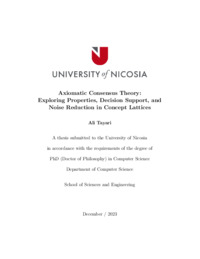- Tayari, Ali
- School of Sciences and Engineering
- Department of Computer Science
- 23 June 2025
- English
- 124
- Domenach, Florent | Portides, George | Savva, Andreas
- Social Choice Theory | Arrow’s Impossibility Theorem | Axiomatic Properties | Formal Concept Analysis | IACP | Consensus Functions | Decision Aiding | DASACT | Concept Lattice Noise Reduction
- Social Choice Theory -- Axiomatic Properties
-
-
This thesis provides a comprehensive exploration of the integration of individual preferences into group decision-making processes, a central focus of social choice theory. It critically investigates various properties that impact selection and voting processes, shedding light on the complexities of creating representative choices from individual preferences. The thesis addresses three key research questions: How can Formal Concept Analysis be used to investigate relationships among properties in consensus functions? How can individual preferences be effectively integrated into
group decision-making processes? And, how can various similarity measures be combined to simplify complex lattices?
The research delves into Arrow’s Impossibility Theorem, a notable work in social choice theory. It underscores the theorem’s relevance, highlighting the inherent limitations and trade-offs of any social choice system. The study explores the relationships among axiomatic properties, particularly in cases where preferences follow a hierarchical order rather than a linear one. This exploration provides a nuanced understanding of the challenges in achieving a ’fair’ voting system and the potential alternatives that could satisfy as many constraints as possible.
A significant portion of the research is dedicated to the application of Formal Concept Analysis (FCA). FCA is used as a method for investigating the relationships among properties in consensus functions, providing a systematic approach to analyze the relationships between these variables.
The study introduces a decision aiding software tool, DASACT, designed to simplify decision-making based on individual preferences. DASACT allows users to select a set of properties to be included, excluded, or ignored when choosing the most suitable function. This tool is particularly useful in scenarios with vast amounts of knowledge presented on complex structures, contributing to the development of more effective decision-making tools.
The thesis further delves into the concept of lattice noise reduction. It proposes an iterative approach for identifying and removing ’noisy’ concepts, i.e., those that do not contain much intrinsic knowledge or are highly similar to their neighbours. The effectiveness of this noise reduction approach is evaluated using similarity measures on lattices. This evaluation provides valuable insights into the potential for simplifying complex lattices and the effectiveness of the proposed approach in preserving as much information as possible.
-


